
This Retro Gaming Handheld Feels Like a Game Boy For Adults

If the Valve Steam Deck, the Nintendo Switch, and the many devices from Ayaneo are pushing the limits of handheld gaming, the Anbernic RG35XX retreats to a more comfortable and familiar time. Looking about as close to the original Game Boy as a device can get before Nintendo’s lawyers step in, the handheld focuses on the pre-3D era of gaming, back when side-scrollers ruled the earth. For the price, it’s a great device, but it gets even better if you’re open to a software upgrade from its devoted community of developers.
Over the years, Anbernic’s handhelds have been getting more powerful and more capable, with recent premium touchscreen models that run Android and even Windows bringing their capabilities closer to handhelds like the Steam Deck. So why does the regressive Anbernic RG35XX exist? That’s easy: it’s an answer to last year’s wildly popular $60 Miyoo Mini, which struck a solid balance between price, nostalgia, and performance. The Miyoo Mini was easily our favorite retro gaming handheld of last year, but its creators struggled to keep it in stock. It was seemingly always sold out, so Anbernic decided to capitalize on its competitor’s stock woes and create an alternative that focused on the same things; a good balance of price and performance, but with some improvements of its own.
Read more
Note: A sample of the Anbernic RG35XX was provided to Gizmodo by online retailer, KeepRetro.
The Game Boy For the 21st Century
It’s a real testament to Nintendo’s hardware team that, 34 years after its debut, the Game Boy’s design is still being copied and used for modern handhelds.
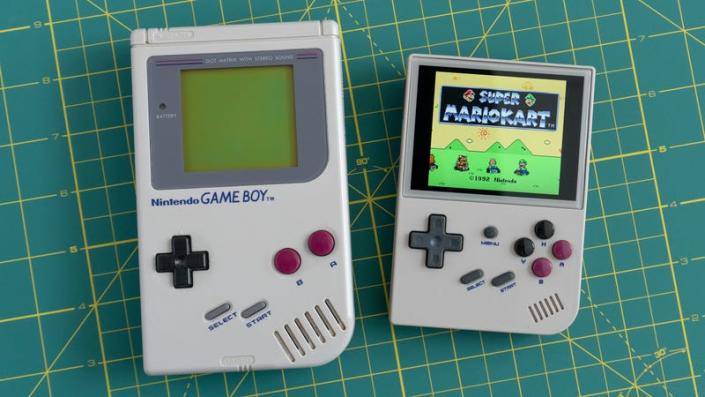
The original Nintendo Game Boy (left) next to the Anbernic RG35XX (right).
The Anbernic RG35XX even cribs the Game Boy’s gently rounded lower right corner, its speaker grill placement, and the layout of all of its buttons, including Select and Start.

The Anbernic RG35XX’s controls feel great, and recreate the layout used on the Game Boy and the Super Nintendo’s gamepad.
At this point, Anbernic knows how to deliver buttons that feel just like what was included on the classic controllers of yesteryear, and the RG35XX feels no different.
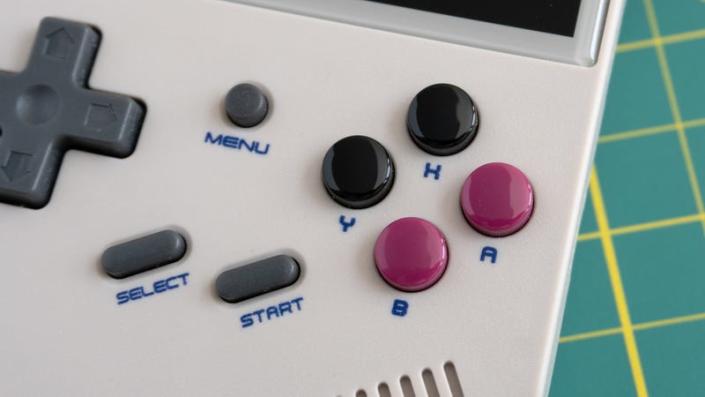
Someone please make the ‘X’ button label actually look like an ‘X’ on Anbernic’s handhelds.
Skip ahead if you’re not interested in an “old man yells at cloud” moment, but someone needs to edit the font being used to label the controls on many of the handhelds coming out of China these days. That is not an X; it’s an H with dimples. Were I more steady with a Sharpie, I would definitely fix this myself. But other than that, Anbernic has delivered some really solid looking and feeling hardware with the RG35XX. It not only doesn’t feel like corners have been cut, but also includes several welcome upgrades over the Miyoo Mini.
A Definite Miyoo Mini Upgrade
I’ve reached for the Miyoo Mini more frequently than any of the other handhelds scattered across my desk, but I’m not going to claim its hardware is perfect.

The Anbernic RG35XX (left) compared in size to the smaller Miyoo Mini (right).
One of the many reasons retro gamers embraced the Miyoo Mini was because of its compact size, which is easy to slip into a pocket. And while I don’t disagree that its smaller size was a big plus, it also made the handheld feel cramped in my larger hands. The Anbernic RG35XX is noticeably larger than the Miyoo Mini (but by no means gigantic), and as a result, I find it to be far more comfortable to hold and play—especially for longer gaming sessions.
The RG35XX’s 640×480 fully laminated screen (meaning no dust is going to find its way inside the panel), while far from being Anbernic’s best handheld display, is also much better than the Miyoo Mini’s. Colors look more saturated, and the viewing angles are far more forgiving. Even just a slight turn of the Miyoo Mini makes the colors seem to drain from its screen, whereas the RG35XX can be positioned at an extreme angle before there’s any noticeable drop in color saturation and contrast.
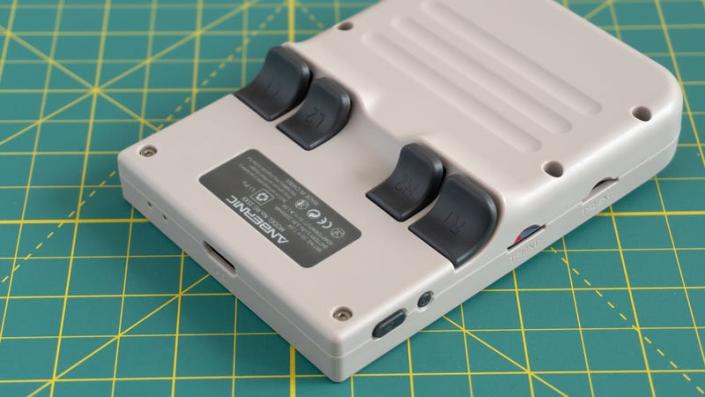
The curve of the Anbernic RG35XX’s shoulder buttons makes them stick out quite a bit on the back, but also makes them easier to feel and press with your fingertips.
I’m also a big fan of the shoulder buttons on the back of the RG35XX. They stick out a lot farther than the shoulder buttons on the back of the Miyoo Mini do, and have a pronounced curve to them, making it really easy for index fingers to grab on to each button’s protruding edge and press. I would have preferred the RG35XX’s inner and outer shoulder buttons to be positioned at different heights so they would be easier to differentiate by feel alone, but it’s a minor complaint.

Anbernic managed to squeeze HDMI connectivity into the RG35XX so games can be played on a larger screen, but you’ll need a Mini-HDMI adapter.
Anbernic has even included an HDMI port on the RG35XX for those wanting to connect it to a larger screen. It’s, unfortunately, a Mini-HDMI port, meaning you’ll need to get an adapter if you don’t already have an HDMI cable with that smaller connector on one end. But it’s a nice upgrade, particularly since the RG35XX can be used with a wired controller connected to its USB-C port, or even with a wireless 2.4Ghz gamepad. Sorry, no Bluetooth or wifi on this one.
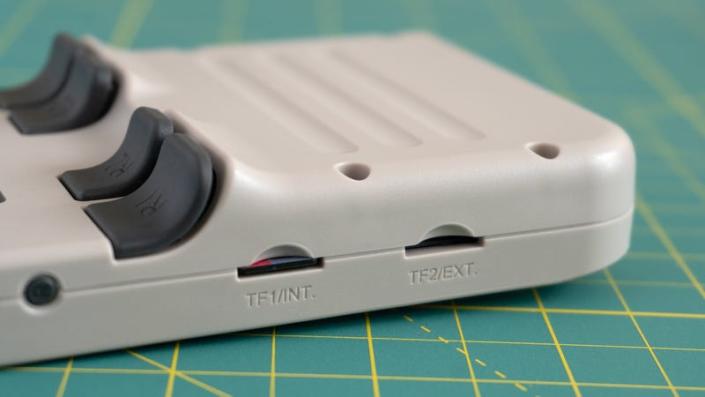
As has long been Anbernic’s approach, the RG35XX has dual microSD card slots allowing the OS and game files to optionally exist on separate carts.
Anbernic has been including dual microSD card slots on its handhelds for years, and that includes the RG35XX. It allows users to keep the device’s operating system on one card, and their game files on another, making for easy swapping between devices. The Miyoo Mini features just a single slot, requiring all the device’s OS and game files to be put on a single card. That’s not necessarily inconvenient, but does sometimes make it harder for users who like to regularly install alternate operating systems or RetroArch front-ends.
A Note on Emulation: Unlike the consoles from Nintendo, Sega, Sony, and Microsoft, which run software from cartridges, discs, or by downloading it from official online game stores, many third party retro handhelds like this rely on ROM files played through software emulation. A certain level of technical competency is required to get ROM files onto a retro handheld, and to configure the emulators for optimal gameplay performance. Using ROM files to play games instead of their original distribution media is also a legal gray area. Although emulation software and frontends such as RetroArch have not faced any major legal challenges to their development, companies like Nintendo have used legal means to shut down websites providing ROM files for download.
Garlic(OS) Makes the Linux Experience Much Better
The best reason to buy the Miyoo Mini didn’t actually exist when the handheld was launched. It arrived about a month after the handheld was released.
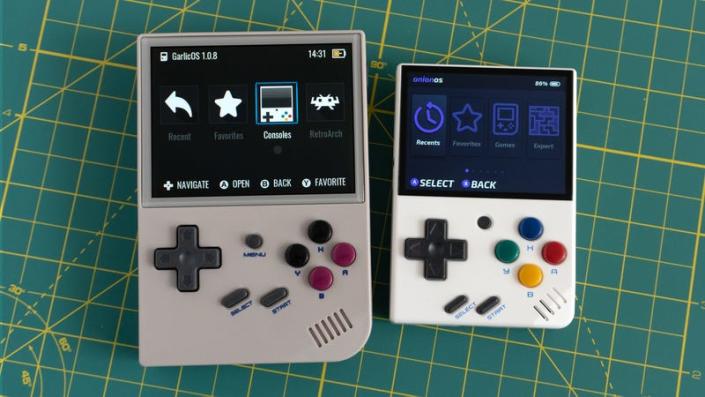
You can greatly improve your Anbernic RG35XX (left) experience by installing a third-party OS alternative called GarlicOS, inspired by the OnionOS for the Miyoo Mini (right).
One of the most common complaints I’ve had with the handheld emulators coming out of China has been the sketchy software they ship with. It often lacks just too much polish and usability, particularly for consumers who are used to the sleek and refined software on their other mobile devices. Many handheld emulators now run Android, which has helped the issue, but the Miyoo Mini’s software woes were actually solved by a community development team that created an alternate operating system for the handheld called OnionOS.
It wasn’t just a welcome facelift for the Miyoo Mini. OnionOS was also a streamlined and simplified front-end for RetroArch, with individual emulators arriving pre-configured and optimized for the Miyoo Mini’s screen and hardware. It made the Miyoo Mini feel more like a device from a company like Nintendo, which spends a lot of money on UI and design, and it helped make the handheld more accessible for even novice users. It was also relatively easy to install, and completely free for anyone to use. (The OnionOS GitHub has an easy-to-follow installation wiki, as do sites like Retro Game Corps.)
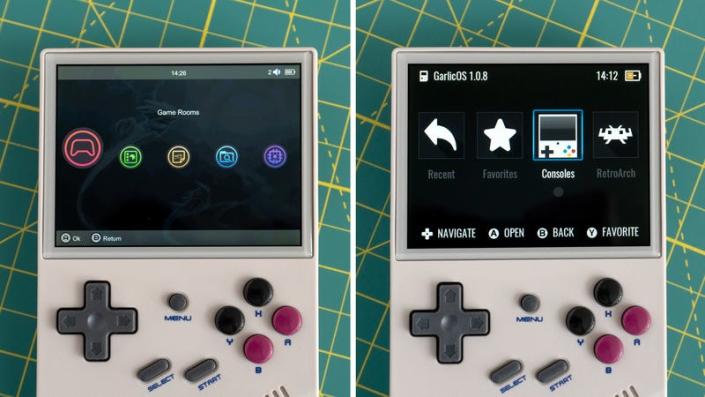
The stock operating system the Anbernic RG35XX ships with (left) is useable, but it lacks polish and the optimizations introduced with GarlicOS (right).
The Anbernic RG35XX’s stock operating system isn’t necessarily bad, or even one of the ugliest I’ve used; it just continues the trend of lacking polish. Thankfully, a developer who goes by the name Black-Seraph, has created an OnionOS-like alternative for the RG35XX called GarlicOS. It’s not quite as robust as OnionOS is, but it puts a much prettier face on RetroArch, makes the various emulators easier to tweak, and introduces a host of button combo shortcuts that help make the RG35XX more enjoyable to use and large collections of games easier to navigate.

GarlicOS on the Anbernic RG35XX allows you to quickly toggle through overclocking and underclocking modes for improved performance or better battery life, which are indicated on the battery icon in the corner of the screen.
There are a few small hiccups with GarlicOS in its latest form, including a battery meter that isn’t entirely accurate and some quirks with HDMI output, but one feature that I think completely justifies the upgrade is the ability to quickly toggle overclocking and underclocking modes by simply pressing the Select button on the home screen (the battery meter will display + or – symbols depending on the level of performance tweaks you currently have up). Super Mario World 2: Yoshi’s Island is one of my all time favorite retro titles, and being able to easily overclock the RG35XX makes the game play quite well on the handheld. Conversely, for simpler games, you can also underclock the device to help max out its four to five hours of battery life.
You can download GarlicOS for free here, but I recommend following Retro Game Corps’ thorough GarlicOS installation guide if you plan to upgrade the RG35XX.
A Worthy Retro Gaming Alternative
Before you even consider the Anbernic RG35XX, you need to ask yourself what kinds of retro games you want to play. Because with an older quad core ARM Cortex-A9 processor, 256MB of RAM, and no analog joysticks, it’s really only going to be able to handle games from the original Sony PlayStation and earlier, including classics from the SNES, the NES, the Genesis, the Game Boy, and the GBA. If you want to run Dreamcast titles or N64 games, this simply isn’t the handheld for you. You’ll get the most enjoyment from it by sticking with 8-bit and 16-bit titles.
Is it better than the Miyoo Mini? Absolutely, and as much as I love how small the Miyoo is, I find the larger RG35XX to be far more comfortable to hold. Anbernic has delivered a very solid handheld here, and it’s even better if you’re willing to upgrade it with some custom software.

The Anbernic RG35XX’s rocker-style volume controls. It’s not the best sounding handheld we’ve ever tested when relying on its built-in speaker, but it still comes with a headphone port if you’re looking for better quality sound.
But whether you should choose the Anbernic RG35XX over the Miyoo Mini is a moot point, because one of the reasons the Miyoo was so hard to find was the very limited supply of its 2.8-inch LCD displays, which has apparently now been depleted. Last month, the company tweeted that the very last batch of Miyoo Minis would be released in February, as it simply couldn’t find another supplier for the smaller display panels.
Between February 5 and 10, the last batch of 200 units of the normal miyoo mini will be released because a supplier for the screen has not yet been found, so after that batch only the miyoo mini + will be sold there is no information from when the normal miyoo mini will return.
So is the Anbernic RG35XX the way to go now? Yes and no. Although the Miyoo Mini might be dead, there’s now a successor, the Miyoo Mini Plus, featuring a larger screen that’s supposedly easier to keep in stock. Will it be a better option than the Anbernic RG35XX? We’ll have a review of the Miyoo Mini Plus soon, and will definitely weigh in on which one you should get.
More from Gizmodo
Sign up for Gizmodo’s Newsletter. For the latest news, Facebook, Twitter and Instagram.
